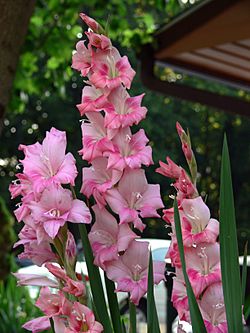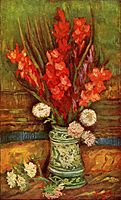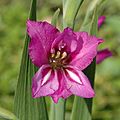Gladiolus facts for kids
Quick facts for kids Gladiolus |
|
|---|---|
 |
|
| Gladiolus | |
| Scientific classification | |
| Kingdom: | |
| Division: | |
| Class: | |
| Order: | |
| Family: | |
| Subfamily: |
Ixioideae
|
| Tribe: |
Ixieae
|
| Genus: |
Gladiolus
|
Gladiolus are beautiful flowering plants that belong to the iris family. Their name comes from a Latin word, gladius, which means "sword." This is because their leaves are long and shaped like swords! People often call them "sword lilies." You can say "gladiolus" for one flower, or "gladioli" (or "gladioluses") for many.
Contents
About Gladiolus Plants
Gladiolus plants come in many different types, called species. There are about 260 known species. Most of them, around 250, grow naturally in sub-Saharan Africa, especially in South Africa. A few species, about 10, are found in Europe and Asia. Some gladiolus plants are very small, while others grow into huge, impressive flower spikes that are popular in flower shops.
How Gladiolus Grow
These attractive plants are known as perennial herbs. This means they live for more than two years and have soft stems, not woody ones like trees. They grow from round, underground stems called corms. These corms are like bulbs and are covered in several layers of brownish, tough fibers.
Their main stem usually grows straight up without branches. It produces about 1 to 9 narrow, sword-shaped leaves. These leaves have grooves along their length and are wrapped at the bottom by a protective layer.
Gladiolus Flowers
Gladiolus flowers grow in tall, fragrant spikes. Each spike has many flowers, usually on one side. The flowers are bisexual, meaning they have both male and female parts. Each flower is protected by two tough, green leaf-like structures called bracts.
The parts that look like petals and sepals are almost the same. They are called tepals. These tepals join together at their base to form a tube. The largest tepal arches over the three male parts of the flower, called stamens. The other three tepals are narrower. The whole flower looks like a funnel.
Seeds and Colors
After the flower is pollinated, the bottom part of the flower, called the ovary, develops into a fruit. This fruit is a capsule with three sections. It contains many brown, winged seeds. These seeds are released when the capsule splits open.
Gladiolus flowers come in many amazing colors! You can find them in shades of pink, red, light purple with white marks, white, cream, orange, and even bright red.
How Gladiolus are Pollinated
In their natural homes in South Africa, gladiolus flowers were first pollinated by bees with long tongues. Over time, some gladiolus plants changed so they could be pollinated by other animals. These include sunbirds, different types of moths (like owlet moths and hawk moths), and long-tongued flies.
In cooler parts of Europe, some of the large garden gladiolus flowers can be pollinated by small wasps. However, wasps are not the best pollinators for these big flowers because they are so small. A well-known European hawk-moth called Macroglossum stellatarum also visits gladioli. This moth usually pollinates other popular garden flowers like Petunia and Zinnia.
The larvae (young forms) of some Lepidoptera species, like the Large Yellow Underwing moth, also eat gladiolus plants.
Gladiolus in Culture
Gladiolus flowers are special to many people and have appeared in different parts of culture:
- The singer Morrissey, from the band The Smiths, was famous for dancing with gladiolus flowers in his back pocket or hands. You can see him swinging yellow gladiolus in the music video for "This Charming Man".
- The Australian comedian Dame Edna Everage always used gladiolus flowers as her signature prop. She called them "glads."
- Gladiolus flowers are traditionally given for a fortieth wedding anniversary.
- Gladiolus is the special flower for the month of August.
- "Gladiolus Rag" is the name of a rag song written in 1907 by Scott Joplin.
- "Gladiolus" was the word that Frank Neuhauser spelled correctly to win the very first National Spelling Bee in 1925.
- Gladiolus in art
-
Vase with Red Gladioli (1886) by Vincent van Gogh
Images for kids
See also
 In Spanish: Gladiolus para niños
In Spanish: Gladiolus para niños












